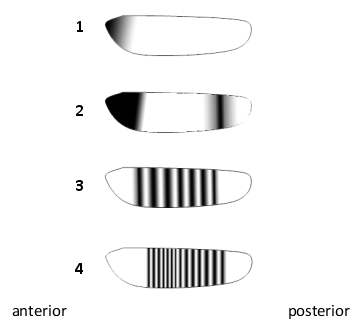Course
Cell Biology
Study Pack
Set 21 Development Of Multicellular Organisms
Question 1
(Short Answer)
Free
Indicate whether each of the following groups of genes typically creates a transient pattern in the developing embryo (T) or a long-lived pattern that is preserved (L). Your answer would be a five-letter string composed of letters T and L only, e.g. TTTLT.
( ) Egg-polarity genes
( ) Pair-rule genes
( ) Hox genes
( ) Gap genes
( ) Segment-polarity genes
( ) Egg-polarity genes
( ) Pair-rule genes
( ) Hox genes
( ) Gap genes
( ) Segment-polarity genes
Answer
Egg-polarity, gap, and pair-...
View full Answer
Question 2
(Short Answer)
Free
Indicate true (T) and false (F) statements below regarding animal development. Your answer would be a four-letter string composed of letters T and F only, e.g. FFFF.
( ) A fertilized egg is totipotent.
( ) Differences in their regulatory DNA can largely explain the differences between animal species.
( ) Inductive signaling is mostly mediated through G-protein-coupled receptors.
( ) A cell's response to a signal depends on its exposure to other signals at that present time as well as in the past.
( ) A fertilized egg is totipotent.
( ) Differences in their regulatory DNA can largely explain the differences between animal species.
( ) Inductive signaling is mostly mediated through G-protein-coupled receptors.
( ) A cell's response to a signal depends on its exposure to other signals at that present time as well as in the past.
Answer
A fertilized egg is totipotent, able t...
View full Answer
Question 3
(Short Answer)
Free
In a developing Drosophila melanogaster embryo, a hierarchy of gene regulatory interactions subdivides the embryo to regulate progressively finer details of patterning. For each of the following proteins, indicate which expression pattern (1 to 4) in the schematic drawing below is more appropriate. Your answer would be a four-digit number composed of digits 1 to 4 only, with each digit used once, e.g. 3412.

( ) Hunchback (product of a gap gene)
( ) Engrailed (product of a segment-polarity gene)
( ) Bicoid (product of an egg-polarity gene)
( ) Even-skipped (product of a pair-rule gene)

( ) Hunchback (product of a gap gene)
( ) Engrailed (product of a segment-polarity gene)
( ) Bicoid (product of an egg-polarity gene)
( ) Even-skipped (product of a pair-rule gene)
Answer
In the regulatory hierarchy of egg-pol...
View full Answer